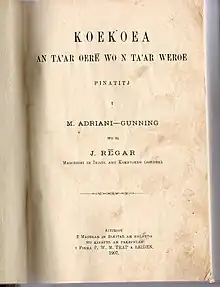| Tontemboan | |
|---|---|
| Native to | Indonesia |
| Region | North Sulawesi |
Native speakers | (150,000 cited 1990)[1] |
Austronesian
| |
| Latin | |
| Language codes | |
| ISO 639-3 | tnt |
| Glottolog | tont1239 |

Tontemboan is an Austronesian language, of northern Sulawesi, Indonesia. It is a Minahasan language, a sub-group of the Philippine languages.[2]
Some lexical influence originates from European and other non-Minahasan languages, such as Dutch, Spanish, Portuguese, Malay, and Ternate.[3]
Name and dialects
Other names and dialect names are: Makela'i-Maotow, Makelai, Matana'i-Maore', Matanai, Pakewa, Kumawangkoan, Tompakewa, Tumompaso, Sonder, and Tountemboan.[4]
Phonology
Consonants
| Labial | Alveolar | Palatal | Velar | Glottal | ||
|---|---|---|---|---|---|---|
| Nasal | m | n | ɲ | ŋ | ||
| Plosive/ Affricate |
voiceless | p | t | tʃ | k | ʔ |
| voiced | b | d | dʒ | (ɡ) | ||
| Fricative | s | ɣ | h | |||
| Rhotic | r | |||||
| Lateral | l | |||||
| Approximant | w | j | ||||
- /ɣ/ can be heard as [ɡ] in free variation.
- /s/ may also be pronounced as [ʃ] when before front vowels.
Vowels
| Front | Central | Back | |
|---|---|---|---|
| Close | i | u | |
| Mid | e | ə | o |
| Open | a |
- Vowels /e/ and /u/ can have allophones of [ɛ] and [ɯ].[5]
Usage
As of 2013, an estimated 100,000 people speak the language, but it is not being passed on to children. It is used in the areas of Sonder, Kawangkoan, Tompaso, Langowan, Tumpaan, Suluun, Amurang, Kumelembuai, Motoling, Tompaso Baru, and Modoinding.[6] Documentation of the language assembled by missionaries in the early 20th century is relatively inaccessible to Tontemboan speakers, as it is written in the Dutch language.[7]
In 1907, Firma P.W.M Trap, Leiden, Holland published a Bible in the Tontemboan language. It was edited by Maria Lamberta Adriani-Gunning and Johannis Regar.
Vocabulary
| English | Tontemboan[8] |
|---|---|
| one | esa |
| two | rua |
| three | tellu |
| four | epat |
| five | lima |
| six | enem |
| seven | pitu |
| eight | wallu |
| nine | siou |
| ten | mapulu |
| north | monge |
| south | meko |
| west | mako |
| east | mico |
| water | rano |
| shower | lemele |
| eat | kuman |
| work | tamawoy |
| fire | api |
| ear | lunteng |
| cold | utiŋ |
| large | wangkər |
| I | aku |
| you | angko |
| know | -taʔu |
| say | nuwu |
References
- ↑ Tontemboan at Ethnologue (18th ed., 2015) (subscription required)
- ↑ Liao (2008), p. 3
- ↑ Schwarz (1908b)
- ↑ OLAC resources in and about the Tontemboan language
- ↑ Lomban Ticoalu, H. Th.; et al. (et al.) (1984). Struktur Bahasa Tontemboan. Jakarta: Pusat Pembinaan dan Pengembangan Bahasa, Departemen Pendidikan dan Kebudayaan.
- ↑ Sneddon (1970), p. 16
- ↑ Bruce Wallace (Director) (2013-10-10). "When New Yorker Rose Monintja speaks her native tongue, the memories flood back". The World. Public Radio International. Retrieved 2013-10-16.
- ↑ Sneddon (1970), pp. 20–26
Sources
- Schwarz, J. A. T. (1907a). Tontemboansche Teksten (in Dutch). Vol. 1. 's Gravenhage: Martinus Nijhoff.
- Schwarz, J. A. T. (1907b). Tontemboansche Teksten (in Dutch). Vol. 2. Leiden: E. J. Brill.
- Schwarz, J. A. T. (1907c). Tontemboansche Teksten (in Dutch). Vol. 3. 's Gravenhage: Martinus Nijhoff.
- Schwarz, J. A. T. (1908a). Hoofdstukken uit de Spraakkunst van het Tontemboansch (in Dutch). Uitg. door Koninklijk Instituut voor de Taal-, Land- en Volkenkunde van Nederlandsch-Indië [bij] M. Nijhoff.
- Schwarz, J. A. T. (1908b). Tontemboansch-Nederlandsch Woordenboek met Nederlandsch-Tontemboansch Register (in Dutch). E. J. Brill.
- Liao, Hsiu-chuan (2008). "A Typology of First Person Dual Pronouns and Their Reconstructibility in Philippine Languages". Oceanic Linguistics. 47 (1): 1–29. doi:10.1353/ol.0.0002. JSTOR 20172338. S2CID 144968420.
- Sneddon, J. N. (1970). "The Languages of Minahasa, North Celebes". Oceanic Linguistics. 9 (1): 11–36. doi:10.2307/3622930. JSTOR 3622930.